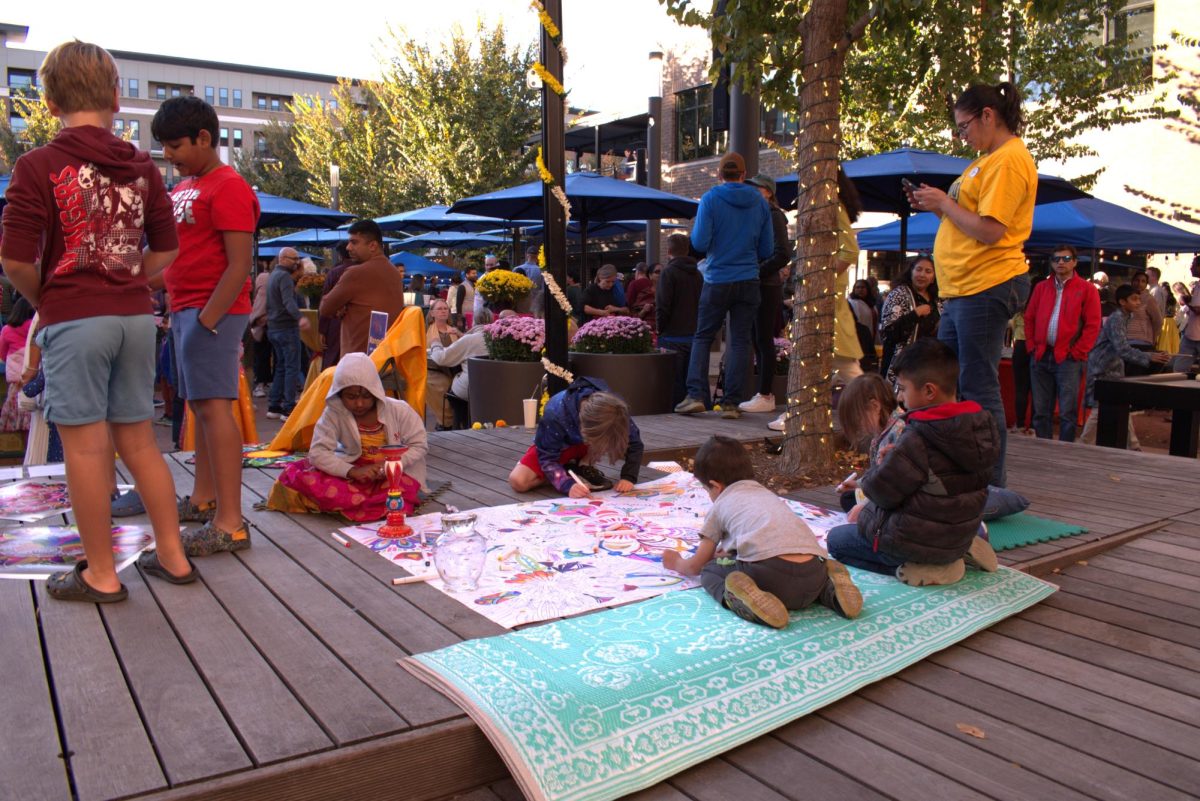By Renny Logan
<[email protected]>
Rachel “Rachelle” Johnson, The Healthy Environment club co-president and senior, said when she packs her lunch each day she utilizes reusable plastic containers. She also owns a sturdy plastic water bottle that she refills, rather than using disposable ones.
In these two ways, Johnson does her part to help the environment. She doesn’t just recycle, she said, but also reuses.
While she acknowledges efforts like Johnson’s to recycle and reuse, Fran Rushing, AP Environmental Science teacher, said the American society often forgets the third “R” of conservation – “reduce” – and this oversight contributes to the environmental quagmire through over consumption even when purchasing “green products.”
“It takes energy and it takes resources to make all those products.” Rushing said. “Are these companies that are making these so-called green products really doing you a favor or are they not?”
She points out that such companies could be producing just as many emissions, just as much water pollution and using just as many resources unbeknownst to consumers.
On the other hand, Johnson looks at the issue of reduction in respect to American society and the current economy. She said that reduction, especially in this economy, is not the best choice for the country.
Johnson recognizes the nature of our culture, “I understand that we are a consumer society, and I don’t think it’s reasonable that we’re going to cut back. But we should be using things we can reuse or recycling what we do use.”
According to a 20-minute documentary titled “The Story of Stuff,” by environmental activist Annie Leonard, Americans should focus on the real issue: our rate of consumption. In the film, Leonard leads the viewer through each step of production to showing how environmental and social problems arise.
While Johnson acknowledges the rate of consumption causes environmental issues, she also said humans don’t “give back.” She said our society has become accustomed to current rates of consumption and that reduction goes against this trend.
“I think people should reduce, but (reusing and recycling) are more reasonable,” Johnson said. “I think (reusing and recycling) are better for our economy.”
Rushing said she agrees with this sentiment. “Our economy is geared for consumption, that’s the way it works,” she said.
However, because recycling can involve just as much energy usage as production, Rushing said she suggests that recycling does not compensate for the absence of reducing and reusing. She said the inefficiency of current recycling methods contributes to the inability of recycling to adequately resolve the situation. Instead, to have the best impact, Rushing said she advises a combination of reduction, reuse and recycling.
“We definitely don’t reuse most things,” she said. “That goes with what (“Story of Stuff”) was explaining; that we’ve designed our culture in the last 50 years to not do that. Throw it away, buy a new one, throw it away, buy a new one.”
In “Story of Stuff,” Leonard also explained the concepts of planned and perceived obsolescence. The term “planned obsolescence” describes when companies specifically design a product to break after a certain amount of time in order to keep consumers buying.
“Some products are not made to last; they‘re made to just be okay for a couple of years maybe and then they’ll start falling apart. And you’ll go ‘Oh, I have to buy a new one,’” Rushing said.
Similar to planned obsolescence, “perceived obsolescence,” has the same affect; it keeps consumers buying, but on a much more subconscious level, as Leonard explains. Perceived obsolescence occurs through advertising, which emphasizes fashion trends and chic new technological devices as necessities.
“Advertising is a component or something that contributes to the problem (of consumption),” economics teacher Michelle Foutz said. “You turn on the TV, and you see ads for bigger and better products than what you currently have. Then you want them more.”
Between advertising and planned obsolescence, consumption rates have soared since the 1950s, when these concepts arose, and to present times.
“The U.S. has more of a problem with consumption than just about any other country in the world,” Foutz said. “I think the (negative savings rate of the United States) is a sign of how much we consume.
“With a negative savings rate, our priority is consumption now. It’s not thinking about ‘are we going to have enough to sustain us in the future?’ It’s just ‘live for the moment,’” Foutz said. “It’s just spend right now, and not even spend what you have, but spend what you don’t have.”




























![Keep the New Gloves: Fighter Safety Is Non-Negotiable [opinion]](https://hilite.org/wp-content/uploads/2024/12/ufcglovescolumncover-1200x471.png)






!["Wicked" poster controversy sparks a debate about the importance of accuracy versus artistic freedom [opinion]](https://hilite.org/wp-content/uploads/2024/11/riva-perspective-cover-1200x471.jpg)









































![Review: “We Live in Time” leaves you wanting more [MUSE]](https://hilite.org/wp-content/uploads/2024/12/IMG_6358.jpg)
![Review: The premise of "Culinary Class Wars" is refreshingly unique and deserving of more attention [MUSE]](https://hilite.org/wp-content/uploads/2024/12/MUSE-class-wars-cover-2.png)
![Introducing: "The Muses Who Stole Christmas," a collection of reviews for you to follow through winter [MUSE]](https://hilite.org/wp-content/uploads/2024/12/winter-muse-4.gif)
![Review: "Meet Me Next Christmas" is a cheesy and predictable watch, but it was worth every minute [MUSE]](https://hilite.org/wp-content/uploads/2024/11/AAAAQVfRG2gwEuLhXTGm3856HuX2MTNs31Ok7fGgIVCoZbyeugVs1F4DZs-DgP0XadTDrnXHlbQo4DerjRXand9H1JKPM06cENmLl2RsINud2DMqIHzpXFS2n4zOkL3dr5m5i0nIVb3Cu3ataT_W2zGeDAJNd_E-1200x884.jpg)
![Review: "Gilmore Girls", the perfect fall show [MUSE]](https://hilite.org/wp-content/uploads/2024/11/gilmore-girls.png)
![Review in Print: Maripaz Villar brings a delightfully unique style to the world of WEBTOON [MUSE]](https://hilite.org/wp-content/uploads/2023/12/maripazcover-1200x960.jpg)
![Review: “The Sword of Kaigen” is a masterpiece [MUSE]](https://hilite.org/wp-content/uploads/2023/11/Screenshot-2023-11-26-201051.png)
![Review: Gateron Oil Kings, great linear switches, okay price [MUSE]](https://hilite.org/wp-content/uploads/2023/11/Screenshot-2023-11-26-200553.png)
![Review: “A Haunting in Venice” is a significant improvement from other Agatha Christie adaptations [MUSE]](https://hilite.org/wp-content/uploads/2023/11/e7ee2938a6d422669771bce6d8088521.jpg)
![Review: A Thanksgiving story from elementary school, still just as interesting [MUSE]](https://hilite.org/wp-content/uploads/2023/11/Screenshot-2023-11-26-195514-987x1200.png)
![Review: "When I Fly Towards You", cute, uplifting youth drama [MUSE]](https://hilite.org/wp-content/uploads/2023/09/When-I-Fly-Towards-You-Chinese-drama.png)
![Postcards from Muse: Hawaii Travel Diary [MUSE]](https://hilite.org/wp-content/uploads/2023/09/My-project-1-1200x1200.jpg)
![Review: "Ladybug & Cat Noir: The Movie," departure from original show [MUSE]](https://hilite.org/wp-content/uploads/2023/09/Ladybug__Cat_Noir_-_The_Movie_poster.jpg)
![Review in Print: "Hidden Love" is the cute, uplifting drama everyone needs [MUSE]](https://hilite.org/wp-content/uploads/2023/09/hiddenlovecover-e1693597208225-1030x1200.png)
![Review in Print: "Heartstopper" is the heartwarming queer romance we all need [MUSE]](https://hilite.org/wp-content/uploads/2023/08/museheartstoppercover-1200x654.png)



